Italian Coffee 101: A Guide & Vocabulary List
Italy made me a coffee drinker. It’s true.
>> To skip past the intro and get straight to the meat of this article, you can use these links to reach Italian Coffee 101, the Italian coffee vocabulary list, and even a list of drinks non-coffee drinkers can enjoy.
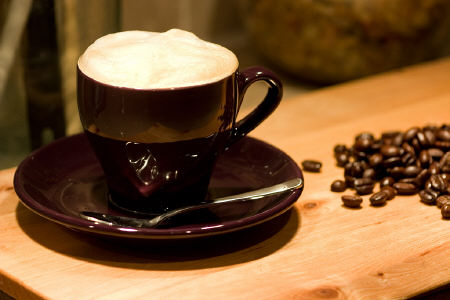 All the way through high school and college, I couldn’t stand the stuff. And after college, when I discovered a “mocha” at the coffee shop near my office, I only kinda liked it. It was better than black coffee, but only just. And after awhile, it turned out that all coffee – even the decaf stuff – gave me ulcer pains. So I stopped drinking coffee of any kind in 1995. (And stop doing math to try to figure out how old I am, ‘kay?)
All the way through high school and college, I couldn’t stand the stuff. And after college, when I discovered a “mocha” at the coffee shop near my office, I only kinda liked it. It was better than black coffee, but only just. And after awhile, it turned out that all coffee – even the decaf stuff – gave me ulcer pains. So I stopped drinking coffee of any kind in 1995. (And stop doing math to try to figure out how old I am, ‘kay?)
Fast forward to early 2008 when I arrived in Milan for what would be a five-week stay in Italy. I was desperate to become a regular at the corner bar by my apartment. I wanted the experience of walking in, smiling at familiar faces, and saying, “The usual, please” – and then having them smile back and know exactly what I wanted. So even though I feared my stomach would rebel instantly and send me into fits of pain that would last for 24+ hours, I started having my daily marocchino at the corner bar. And guess what?
Nothing happened.
Well, not nothing. I did get my coveted “regular” status, and about the middle of my stay in Milan I didn’t even have to say anything but hello to the folks behind the counter before they’d start making my beloved marocchino. But my stomach never rebelled – the ulcer pains never returned. And even after returning to the U.S. and switching to a daily 16 oz. latte (when in Rome, and all that), my stomach seemed to adjust.
So, you see, Italy made me a coffee drinker.
And all of this is a long introduction to a subject that, prior to 2008, held virtually no interest for me but is now near and dear to my heart – Italian coffee. While I’m completely comfortable with the gigantic quantities of coffee I drink in the U.S., I’m a chameleon and switch over easily to the tiny cups of divine Italian coffee I get in Italy. If you’re a die-hard coffee lover, you’ll be taken care of in Italy – but you’ll need to get used to the new names of coffee drinks that you’ll be presented with. The words you think you know as Italian don’t work in Italian coffee shops.
Here, then, is my Italian Coffee 101.
>> I must pay special homage here to my friend Sara, the writer of Ms. Adventures in Italy, whose post about “How to Order an Italian Coffee in Italy” is informative and pretty (she takes lovely pictures of those Italian coffees!).
First, you’ll need to internalize a few things:
- Where do you get your coffee? In a bar. Not a cafe. Not a coffee shop. What we call coffee shops or cafes in the U.S. are called bars in Italy.
- Coffee isn’t meant to be sipped slowly for hours. Italian coffee comes in tiny quantities, and it doesn’t come in to-go cups. You stop at the bar en route to work or school for a quick shot of coffee, and you usually don’t even sit down for it.
- Stopping for a coffee at other points in the day is normal and accepted, and because the quantity is still small, you’re not really at risk of being up all night from a 2pm shot.
- You’ve probably heard that Italians don’t drink cappuccino after 11am; but what this comes from is the Italian belief that drinking milk after a meal screws up digestion. So Italians just won’t order a cappuccino after a meal, no matter what time of day it is. In Italy, a cappuccino is the meal.
- I said it above, but it bears repeating – throw out all that Starbucks-infused Italian-esque mumbo jumbo you think will help you order coffee in Italy. It won’t. You’ve got to start over with your Italian coffee lingo. Your education starts below.
Italian Coffee Vocabulary, including Types of Italian Coffee Drinks
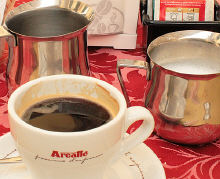 Americano ah|mehr|ee|KAH|noh
Americano ah|mehr|ee|KAH|noh
A caffè Americano is sort of partway between the American-style coffee you’re probably used to and more traditional Italian coffee. It’s espresso that’s been watered down a bit and it’s served in a bigger cup than the tiny espresso cups. Consider this the gateway drug between American coffee and Italian coffee.
 caffè kahf|FEH
caffè kahf|FEH
While caffè is a general term for coffee, when you’re in a bar this is what you’d order if you just wanted a single shot of espresso. Italians don’t order “un espresso,” they order “un caffè.”
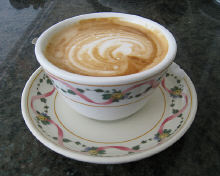 cappuccino kahp|poo|CHEE|noh
cappuccino kahp|poo|CHEE|noh
Probably Italy’s most famous coffee export, the cappuccino is supposed to be roughly 1/3 espresso, 1/3 steamed milk, and 1/3 foam. The history of where the cappuccino gets its name is actually really fun, but don’t worry – there’s no quiz at the bar to order one. And y’know what? If you want to have a cappuccino after lunch, or after dinner, go ahead. The waiter won’t freak out if you order one because you’re not Italian; but if you really want to get into the local swing of things, stick with a straight caffè after a meal.
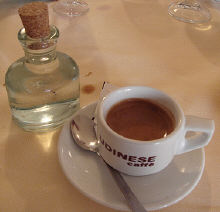 corretto kohr|REHT|toh
corretto kohr|REHT|toh
This coffee drink isn’t for the morning, but it’s a great after-dinner treat. Why? Because it’s a shot of espresso with a shot of liquor. Probably the most common alcoholic additions are grappa, Baileys, or Sambuca, but if the restaurant you’re in has a full bar you can probably have just about anything added that you’d like. (And as my friend René has pointed out, “corretto” means “correct” – insinuating that all other coffee drinks are, therefore, incorrect. But of course!)
Dietor dee|eh|TOR
I’ve never seen an Italian drink a straight shot of espresso (or any other coffee drink) without adding sweetener to it. Most often, that sweetener is sugar – but if you’re trying to stay away from sugar, you can ask if they’ve got Dietor on hand. It’s a brand-name in Italy that’s a saccharin-based sweetener, kind of like Sweet’n’Low.
doppio DOHP|pyoh
That tiny caffè not enough to get you going in the morning? Then order a caffè doppio, a double espresso, for two shots in a slightly larger cup.
espresso ehs|PRESS|soh
As mentioned above (see caffè), an espresso in Italy is called a caffè – so this isn’t a word you’ll use when you’re ordering coffee in Italy.
 freddo FREHD|doh
freddo FREHD|doh
The word “freddo” means cold, and this is usually an espresso that’s been either left out to cool down or actually put in the fridge to speed the process. It’s served cold or cool.
granita grah|NEE|tah
When the summer heat makes drinking a hot cup of caffè unbearable, the Italians make granita di caffè. Think of it like a coffee slushy. Only better. (And a granita comes in more than just coffee flavors – as Karen’s post about Sicilian Granita proves.)
Hag AHG
This is another brand name that’s come to represent everything in its category. In this case, this is decaf coffee. The generic term, un deca, can also be tried if you get blank stares when you start out by ordering un Hag. Either word you use, you can get decaf versions of everything on this list – like a marocchino Hag or a doppio Hag.
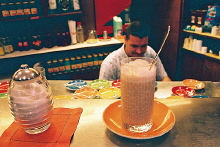 latte LAHT|teh
latte LAHT|teh
Okay, people, this may be your drink of choice in the U.S. (it’s mine), but in Italy this just means “milk.” That’s all. If you order a latte in the corner bar, you’ll get glass of cold milk. There is a coffee drink in Italy that uses this word, but it’s kind of a stretch to call it a coffee drink. In Italy, a caffè latte is basically a tall glass of steamed milk with a small shot of espresso in it. I’ve seen Italians order this, so it’s not totally crazy, you’ve just got to be sure to add the word “caffè” on there if you want something other than a big glass o’milk.
lungo LOON|goh
This word literally means “long,” and this drink is partway between a caffè Americano and a regular Italian caffè. In other words, it’s got more water in it than a caffè, but it’s water that’s been run through the same coffee grounds rather than just hot water added afterwards (the latter is in the case of a caffè Americano), resulting in a slightly weaker flavor than a regular shot of espresso.
 macchiato mah|KYAH|toh
macchiato mah|KYAH|toh
The word “macchiato” comes from the Italian word for “stained,” so this drink is essentially meant to be a shot of espresso “stained” with a drop or two of hot milk. I have friends for whom the amount of milk in a cappuccino is too much, but a straight caffè is too strong – this is their drink of choice.
marocchino mah|rohk|KEE|noh
If you’ve been wondering what my Italian coffee drink of choice is, you’ve found it. And in truth, if you read the introduction to this post instead of just skipping to the vocabulary list you’d have noticed me waxing poetic about the marocchino already. At any rate, what is a marocchino? It’s a shot of espresso, a sprinkle of cacao powder, and a layer of foamed milk. And it’s a little cup of heaven. I have my friend Sara at Ms. Adventures in Italy to thank for finding the marocchino (it’s her favorite drink, too), and I haven’t looked back since. It’s worth noting that you won’t find marocchino on the menu everywhere. I got blank stares in Venice, and Sara says it’s called an espressino in some parts of the country. Be sure to check out Sara’s post for some lovely marocchino pictures.
panna PAHN|nah
This word means “cream,” and in the case of a coffee context it’s referring to the dollop of whipped cream you may or may not want on top of your caffè. You can get panna with any of the coffee drinks listed. Just ask for whatever drink you want con panna.
ristretto ree|STEHT|toh
A caffè ristretto is essentially a single shot of espresso with less water than a traditional shot. So it’s the same amount of coffee with less water passing through it, making the flavor much more concentrated. This can also be called a caffè stretto.
scuro SKOO|roh
The word “scuro” means dark, and you may know it if you buy Italian espresso at home and it’s a dark roast. But in an Italian bar, “scuro” isn’t something you’re likely to use often. One instance when you might is if you like your cappuccino with a little less milk, though not as little as a macchiato – you could order a cappuccino scuro and it would be a bit darker in color than a normal cappuccino.
shakerato shay|keh|RAH|toh
I actually discovered the shakerato while in the U.S., but it was because I was reading the blogs of my Italy expat friends and feeling envious of their summertime coffee drinks. Especially after Cherrye at My Bella Vita posted pictures of her caffè shakerato I knew I had to make my own. Luckily, it’s easy. It’s a shot of espresso mixed with milk, ice, and sugar in a cocktail shaker and served in a tall glass with the foam scooped from the shaker on top. Yum.
zucchero TSOO|keh|roh
This is the Italian word for “sugar,” and also the name of a popular Italian singer. Chances are, however, if you’re ordering coffee, you’re not talking about the singer.
And If You Want the Coffee Experience Without the Coffee
There are non-coffee drinks that every Italian bar will have on the menu. You can, therefore, have your corner bar experience without having to drink something you hate.
caffè d’orzo KAH|feh DORE|tzoh
This is supposed to be a coffee substitute for people who can’t drink coffee, but from what I’ve heard it doesn’t come close to the flavor of real coffee. Perhaps it’s akin to comparing hamburgers with gardenburgers – they’re clearly not the same thing, so really shouldn’t be compared, but one is attempting to stand in for the other. Caffè d’orzo is made from barley, and you can order it in the same ways you’d order caffè – doppio, macchiato, marocchino, cappuccino, etc.
cioccolata calda cho|koh|LAH|tah KAHL|dah
This is an excellent cold weather treat, and although the words mean “hot chocolate” you shouldn’t think this is anything like the watery concoction you make at home. It’s closer to pudding. It’s kind of like drinkable pudding. And it’s so good I wrote a whole post about it. Cioccolata Calda, Italian Hot Chocolate
tè TEH
Not surprisingly, this word means “tea” in Italian. The Italians don’t love their tea the way the English do, but you can get tea in pretty much any Italian bar. Just as in many restaurants in the U.S., when you order tea you’ll usually get a carafe with hot water in it, a tea cup, and a tea bag. It’s not advisable to try to bring in your own tea bag, by the way.
[display_feed=https://www.italylogue.com/tag/food-drink/feed;title=Want to read more about Italian foods? These articles should help:;items=10;desc=0]
original photos, from top to bottom, by: j03, Ian-S, mararie, Kelly Green Rogue, pintxomoruno, mararie, kikmoyoo, magnus*